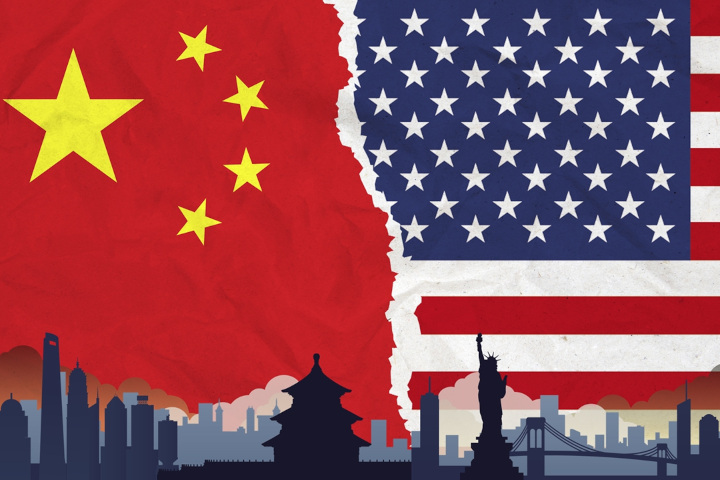
USA-China Mirrors
What will work better between USA and China, short-term economic cycles or long-term systemic assets or baggage? The picture may look not so clear if seen from Beijing.
Beijing has just launched a whole array of measures aimed at compensating for lackluster growth at the beginning of the year, and its main thrust is about pouring money into the market, but this may exacerbate the situation.
«Latest official data shows financial institutions issued 5.5 trillion yuan ($766.12 billion) worth of long-term deposits known as certificates of deposit (CD) in the first quarter of this year — the largest such quarterly issuance since the product was introduced in 2015. Domestic investors have rushed into these CDs over the past year in a desperate search for returns as they withdraw from real estate and the stock market, both traditional investment options now looking treacherous because of regulatory and economic problems. Companies have joined the scramble this year, adding to the drag on China’s economy. It effectively means businesses and households are hoarding cash rather than investing it, despite lower interest rates. This classic liquidity trap plagued Japan for years beginning in the 1990s».[1]
It means that so far, people and companies don’t want to spend their money; it’s not that they have no money to spend in the market. If so, Beijing’s cash injections will not work because supply-side answers don’t solve demand-side questions.
It looks like Japan’s 1980s liquidity trap. What can Beijing do to kickstart demand and give confidence to consumers and investors? Why do they lose confidence? This might be the crux of the matter, and it’s not simply financial.
At least three elements contribute to the situation. The real estate market, for over two decades the main driver of growth, collapsed. Now, it languishes, with possibly up to 100 million unsold finished apartments. Real estate accounts for some 60% of the outstanding bank loans.
No other engine can replace real estate at the moment. Infrastructure building was the other significant driver with long-term and low returns, and meanwhile, it blew up the local and national debt.
Moreover, investors and consumers have grown more timid. A decade of anti-corruption campaigns has scared many entrepreneurs who initially made money while cutting many corners. Plus, longstanding anti-Covid measures choked the markets for three years instead of one year for other countries. Now, many still feel the aftershocks. Finally, the tense international situation and the threat of sanctions cast a shadow over foreign trade.
The accumulation of all these problems could crush the Chinese economy and thus spread into society and politics. Chinese leaders know it. They are pragmatists, not ideologues, and before these issues, they radically changed course in the past. Then the question is whether we can expect a dramatic turn in China soon.
Some changes will happen for sure; however, how radical they will be is an open question because the Chinese are still unsure about the example America is giving them.
A picture from two sides
The Chinese see a list of intertwined problems in the US that make China look safer and better in comparison.
Here is a brief summary list:
- Overuse of legal and illegal opioids and drugs sold quite freely
- Spread of firearms and violence, unsafe urban environments
- Poor basic healthcare
- Poor primary and middle school education
- Youngsters all hooked on super-addictive smartphones and games
- Persistent race issues hiding perhaps class issues
- Lousy food, an overweight population, and dropping classical education
- Broken families
- Infrastructure in shambles
Plus, there are American ballooning public debt and doubts about its sustainability, while this question sits in the middle of a complex global trade. Can the USA fix it?
Conversely, Beijing feels that China has been outperforming the US in building long-term social resources.
- Few drugs
- No firearms, safe urban environment
- Improving basic healthcare
- Improving basic education
- New rules limiting children under 18 to two hours of smartphone usage per day
- No racial issues
- Greater study of Western classics, art, and music
- Strong family values
- More infrastructure spending domestically and internationally
The list is simplistic and confusing, as many items would deserve deeper examination. But they are the nuts and bolts of any country, and China here feels, right or wrongly, that it has been outperforming America. Therefore, the present economic difficulties might just be hiccups to be fixed, but that do not require a significant U-turn.
Conversely, do the different political systems favor China or the US in dealing with their respective problems?
Indeed, in both countries, there are vested interests that oppose systemic political change. But China may feel that its political system is better endowed with the levers to undertake necessary modification. Beijing, this time has started a series of measures to turn the economy around.
Conversely, Beijing feels that although Washington sees its problems, it has been unable to make much progress on any of those issues for years. Many have gotten worse. The rich and well-off have good schools, health care, families, and safe environments; the poor have none of the above.
In this way, Mr. Donald Trump’s declared plan to vastly increase presidential powers seems to respond to this crisis of inaction. If Mr. Trump were to become president again, he would be unlikely to improve health care or primary education, which are not on his agenda. But the social divide, the distance between the entitled elites and the growing marginalized ordinary people, creates the resentment that fuels Trump’s outbursts.
In other words, seeing things from Beijing, Trump is the ugly face of American necessity to change. The US reaction may look as if American elites are trying to eliminate Trump and what he stands for without making any difference. This may prove US systemic resistance to necessary reforms.
This situation in America confirms that despite whatever temporary contingencies and vested interests in keeping its system, Chinese elites may feel there are no compelling reasons to alter a political structure that may outperform the US in the long run. This opinion is not based on ideology but on pragmatic perceptions of results. The argument may be partial, tainted, and inaccurate, but it is not ideological like the old Soviet communists.
The Times They are A-Changin
The next few years are crucial to see whether Beijing can get out of its present quagmire and boost domestic confidence, which will drive higher consumption and, thus, better economic performance.
The issue may have more to do with the domestic situation. People may need to feel safe about their assets and protected against future indiscriminate attempts of the authorities to encroach on their properties and to constrain their legal personal freedoms, as happened with the anti-corruption and anti-Covid campaigns.
Here we have a conundrum: These reforms would limit the present boundless power of the party, the one thing that drives the current changes.
Therefore, Beijing might become stuck, trying for lateral moves that won’t correct the big picture, or it might pull a rabbit out of a hat and offer an unexpected solution.
In all of this, it would behoove America to show real progress on all the issues that make the Chinese feel discouraged and hopeless about the US. Real reform in the US could bridge the gap with China and encourage steps in the same direction in Beijing.
On the other hand, if Beijing’s economic performance remains stagnant, it could start some other rethinking in China.
Still, there are historical examples that can be important for both the USA and China.
In the 1960s and 1970s, in the middle of the Cold War, with Presidents Kennedy and Johnson, the US undertook a series of welfare and civil rights reforms that improved the fabric of society and mended fissures that the Soviets could have used to break American social order apart.
The action transformed American life and created some conditions that made it possible for the West to beat the USSR. It wasn’t painless. Some of the problems those reforms brought about have not been digested yet, but they saved the day by addressing structural issues.
The USSR, with Gorbachev, started to address some of its social and political problems only over twenty years later, in the 1980s, and it didn’t go well. With hindsight, many blame the reforms for the fall of the USSR, while the issue was with the systemic faults of the Soviet state.
In other words, the Soviet problems of an almighty bureaucracy stifling all life, and its need for democratization, had to be addressed much earlier. It was when its domestic impact was clear but not so pervasive, at least in the 1950s, after the war and Stalin’s death. The USSR didn’t, problems festered, and when they were attended to, it was too late; the system rejected the reforms and imploded.
Is China now starting its necessary reforms while the US is skirting them? From Beijing, it may look like it, creating an odd situation and a false sense of confidence. Still, the process is complicated and American difficulties are no excuse or salvation from Chinese troubles.
[1] https://www.reuters.com/markets/asia/chinas-stubborn-savers-risk-precipitating-liquidity-trap-2023-08-04/






Dear Francesco, You couldn’t resist the reflex of apologetics:
1. Overuse of legal and illegal opioids and drugs sold quite freely. CHINA PROACTIVELY/STRATEGICALLY FEEDS THE US DRUG CRISIS, VIA FENTANYL THROUGH MEXICO. THE OPIOIDS ISSUE IS SYMPTOMATIC OF ECONOMIC CONDITIONS AND PERVERSE PHARMACEUTICAL INDUSTRY INCENTIVES TO DOCTORS THAT IS BEING HANDLED BY THE LEGAL SYSTEM.
2. Spread of firearms and violence, unsafe urban environments. WELL KNOWN, BUT A CONSTITUTIONALLY BUILT-IN FORM OF NATIONAL DEFENSE STEMMING FROM THE US’s OWN REVOLUTION. WOE TO THE OCCUPIER ATTEMPTING TO DISARM THE POPULATION.
3. Poor basic healthcare. NOT MORE AFFORDABLE IN CHINA. OFFSET SOMEWHAT BY SUPERIOR US MEDICAL RESEARCH AND OPERATIVE CARE. DOCTORS IN CHINA HAVE POOR INCENTIVES: NOT PAID MORE THAN A BARBER AND RELY MUCH MORE ON COMMISSIONS ON PRESCRIBED MEDICATION.
4. Poor primary and middle school education. WELL KNOWN AND COMPENSATED BY SUPERIOR HIGHER EDUCATION
5. Youngsters all hooked on super-addictive smartphones and games. DITTO IN CHINA. KIDS WILL WORK AROUND THE CHINESE CONTROLS NORTH-KOREA STYLE, BY TRAFFICKING IN FILES.
6. Persistent race issues hiding perhaps class issues. INTRINSIC TO MANAGING A MULTI-ETHNIC SOCIETY THAT ENABLES CONTINUOUS POPULATION GROWTH BY IMMIGRATION. RACE ISSUES OF ETHNIC MINORITIES IN CHINA RAISED TO ACCUSATIONS OF GENOCIDE. NEO-MARXIST (MICHEL FOUCAULT) CRITICAL THEORY REDUCES CLASS TO RACE/CULTURE: SO, WORLD, BEWARE OF HAN-CHINESE ETHNO-NATIONALISM.
7. Lousy food, an overweight population, and dropping classical education. BETTER NUTRITION IS CATCHING ON, COMMERCIALIZING. THE AGING WANT TO LIVE LONGER. CLASSICAL EDUCATION IS AN OXYMORON IN CHINA WHERE THE PARTY MANAGES WHAT IS HISTORY ON THE BASIS OF THE PARTY’S ON-GOING POLITICAL SURVIVAL NEEDS.
8. Broken families. CHINA’s DIVORCE RATE NO BETTER. AND CHINA’s FAMILIES HAVE BEEN REDUCED TO THE WORLD’s SMALLEST.
9. Infrastructure in shambles. BETTER ECONOMICALLY THAN OVERBUILT INFRASTRUCTURE, AND MUCH BETTER BUILT FOR MUCH LATER REPLACEMENT. HERE, LAG IS BETTER THAN LEAD SINCE LEAD-TIME IS NOT AN ISSUE, ESPECIALLY IF BIG ECONOMIC GROWTH IS NOT ON/OVER THE HORIZON.
So, here’s a list about the US from the outside-the-Party perspective:
1. Government does not seek to control thought and information, and to change history.
2. Political power does not come from “the barrel of a gun” of the PAP and Public Security
3. Average doctor’s salary is $330,000 per year, much more of it for service than as commission on prescriptions. Public health and hygiene much more advanced. No creation/export of pandemics like SARS and Covid.
4. Multi-ethnicity enables the economy to keep growing by population growth through immigration.
5. Electoral system enables the people to control bad government leadership, and removes the monopoly luxury/arrogance of permanent leadership job security.
6. The market (economic pluralism) determines the economy which determines the government, not the reverse where the government through economic policy determines the market.
7. Majority, consumers’ choice drives the US economy, not minority, producers’/investors’ choice.
8. The US economy is diversified and stable, with half of the share that is devoted in China to property/construction, and dependent more on foreign investors’ willingness to invest than on foreign consumers’ willingness to import.
9. Much more job/career flexibility and adult education, and therefore higher productivity.
10. Infrastructure, albeit aging, built for the long term and largely amortized and thereby productive.
AUTORE: Robert Blohm